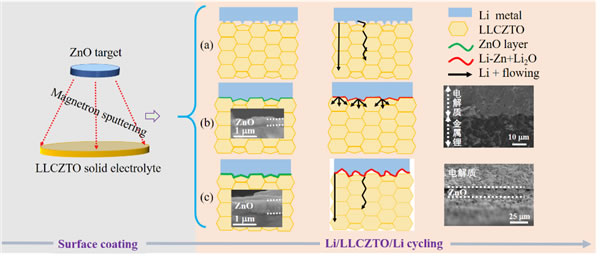Hefei Research Institute has made progress in the research on the interface transition layer of all-solid lithium batteries
Recently, Fang Qianfeng, a researcher of the Institute of Internal Friction and Solid Defects, Institute of Solid Physics, Hefei Academy of Material Sciences, Chinese Academy of Sciences, has made progress in researching the interface transition layer of all-solid lithium batteries. By using ZnO as the interface transition layer between metallic lithium and solid electrolyte, the research group studied its effect on the deposition of lithium ions at the interface and the growth of lithium dendrites, and revealed the influence of the thickness of the ZnO layer on the interface impedance and lithium ion transmission. Related research results were published on ACS Applied Materials & Interfaces under the title of Thickness-Dependent Beneficial Effect of the ZnO Layer on Tailoring the Li / Li7La3Zr2O12 Interface. The all-solid-state battery using metallic lithium as the negative electrode is one of the main development directions for achieving high safety and high energy density lithium batteries. However, due to the poor wettability of lithium metal on the surface of the solid electrolyte, the transmission efficiency of lithium ions at the interface is seriously affected, which in turn leads to high interface impedance and the growth of lithium dendrites, which ultimately leads to battery short circuits, which poses potential safety hazards for lithium battery applications. By adding a ZnO transition layer at the interface between the two, the interface contact effect can be effectively improved, but the related influence mechanism is not yet clear. To this end, the researchers sputtered ZnO transition layers of different thicknesses on the surface layer of Ca / Ta co-doped Li6.55La2.95Ca0.05Zr1.5Ta0.5O12 (LLCZTO) electrolyte by magnetron sputtering. The lithium metal composite is fabricated into a symmetrical all-solid lithium battery. By characterizing its composition, structure and electrochemical performance, the rule of the influence of the thickness of the ZnO layer on the interface impedance and lithium ion transmission is explored (Figure 1). Studies have shown that the ZnO transition layer will undergo side reactions with metallic lithium, leading to volume expansion and some deformation. However, when the thickness of the ZnO transition layer is less than 200 nm, the swelling effect is not obvious. The transition layer will maintain good close contact with the electrolyte layer (Figure 1b); and the excessively thick ZnO transition layer will form wrinkles due to volume expansion , Resulting in a periodic pore structure at the interface, significantly reducing the effective contact area of ​​the interface between the lithium metal and the solid electrolyte (Figure 1c), increasing the interface impedance, and the instability of the interface will cause local deposition of lithium ions at the interface to form dendrites. Causes battery short circuit and reduced cycle life. The results show that the ZnO transition layer with a thickness of less than 200 nm can effectively improve the interface characteristics of all-solid-state lithium batteries. The development of this work provides a theoretical and experimental basis for the optimization of the interface performance and safety performance of all-solid-state batteries. The research work was supported by the National Natural Science Foundation of China and the Natural Science Foundation of Anhui Province. Figure 1. Schematic diagram of the effect of sputtering ZnO coatings of different thicknesses on the surface of a solid electrolyte by magnetron sputtering on the interface stability and lithium ion transport process. (A) No transition layer; (b) A small amount of ZnO; (c) A large amount of ZnO. ZHEJIANG KINGSIR VALVE CO., LTD. , https://www.kingsir-valves.com